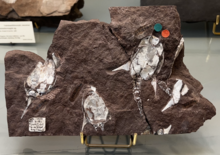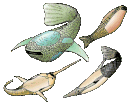| Doryaspis Temporal range: Early Devonian PreꞒ Ꞓ O S D C P T J K Pg N | |
|---|---|

| |
| D. arctica fossils (MNHN.F.SVD653-655) at the National Museum of Natural History, France | |
| Scientific classification | |
| Domain: | Eukaryota |
| Kingdom: | Animalia |
| Phylum: | Chordata |
| Infraphylum: | Agnatha |
| Class: | †Pteraspidomorphi |
| Subclass: | †Heterostraci |
| Order: | †Pteraspidiformes |
| Family: | †Protopteraspididae |
| Genus: | †Doryaspis White 1935 |
| Type species | |
| Doryaspis nathorsti (Lankester 1884) White 1935 | |
| Species | |
| |
| Synonyms | |
| |
Doryaspis (from Greek: δόρῠ dóru 'spear' and Greek: ἀσπίς aspís 'shield') (also known by its synonym, "Lyktaspis") is an extinct genus of primitive jawless fish that lived in the Devonian period. Fossils have been discovered in Spitsbergen.
The animals had canteen-shaped body armor and had large branchial plates that extended out and curved downward in a triangular shape, very similar to those of the pycnosteids. An element of the median oral plates (that would correspond to the lower lip or chin in gnathostomes) extends out in a long rod-shaped appendage, called the "pseudorostrum." The tail is long and slender and has large rows of thick scales.
In the type species, D. nathorsti, the lateral edges of the branchial plates and of the pseudorostrum are serrated. The second species, D. arctica, is smaller, and lacks serrated edges.
-
Reconstruction of recently discovered species, D. arctica
-
 Reconstruction of the type species, D. nathorsti
Reconstruction of the type species, D. nathorsti
-
 Reconstruction of D. nathorsti
Reconstruction of D. nathorsti
Palaeoecology
Due to its unusual form, its ecology is debated. There are two hypotheses about lifestyle, to make it a surface pelagic swimmer or a benthic burrower. For pelagic lifestyle, it mostly used its caudal fin to move. Fin-shaped plates may had effect of levitation by increasing the bearing surface of it. Water flows ejected by their gill openings may worked to stabilize and control lateral movements. On the other hand, benthic burrowing hypothesis is supported by its flat dorsal disc. Moving half-buried in the sediments allows it to filter nutrient particles. However, burrowing theory has problems, because gill openings are placed on the lower part of body, risking suffocation. Thus study in 2005 concluded that pelagic theory is more supported than burrowing theory. However, several papers have incorrectly cited this study as supporting burrowing ecology.
References
- Pernègre, Vincent Noël (2005-03-01). "Description d'une nouvelle espèce et analyse morpho-fonctionnelle du genre Doryaspis White (Heterostraci) du Dévonien du Spitsberg". Geobios (in French). 38 (2): 257–268. doi:10.1016/j.geobios.2003.10.005. ISSN 0016-6995.
- Blieck, Alain (2017-09-01). "Heterostracan vertebrates and the Great Eodevonian Biodiversification Event—an essay". Palaeobiodiversity and Palaeoenvironments. 97 (3): 375–390. doi:10.1007/s12549-016-0260-1. ISSN 1867-1608.
- Gai, Zhikun; Lu, Liwu; Zhao, Wenjin; Zhu, Min (2018-09-19). "New polybranchiaspiform fishes (Agnatha: Galeaspida) from the Middle Palaeozoic of China and their ecomorphological implications". PLOS ONE. 13 (9): e0202217. doi:10.1371/journal.pone.0202217. ISSN 1932-6203. PMC 6145596. PMID 30231026.
- THE GENUS DORYASPIS WHITE (HETEROSTRACI) FROM THE LOWER DEVONIAN OF VESTSPITSBERGEN, SVALBARD
- Long, John A. The Rise of Fishes: 500 Million Years of Evolution, Baltimore: The Johns Hopkins University Press, 1996. ISBN 0-8018-5438-5
| Taxon identifiers | |
|---|---|
| Doryaspis | |
This article related to a Devonian jawless fish is a stub. You can help Misplaced Pages by expanding it. |
This article about Pteraspidomorphi is a stub. You can help Misplaced Pages by expanding it. |





